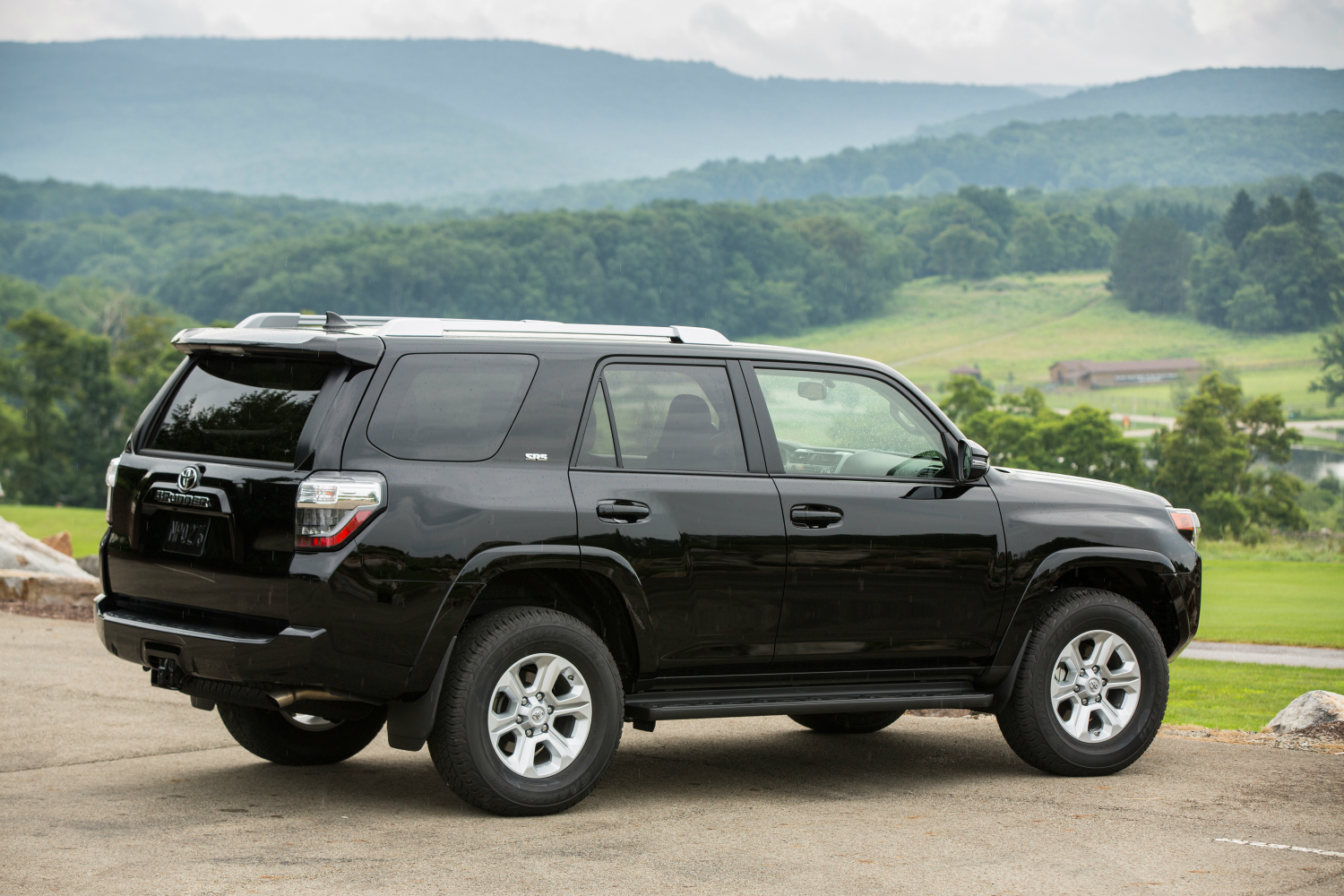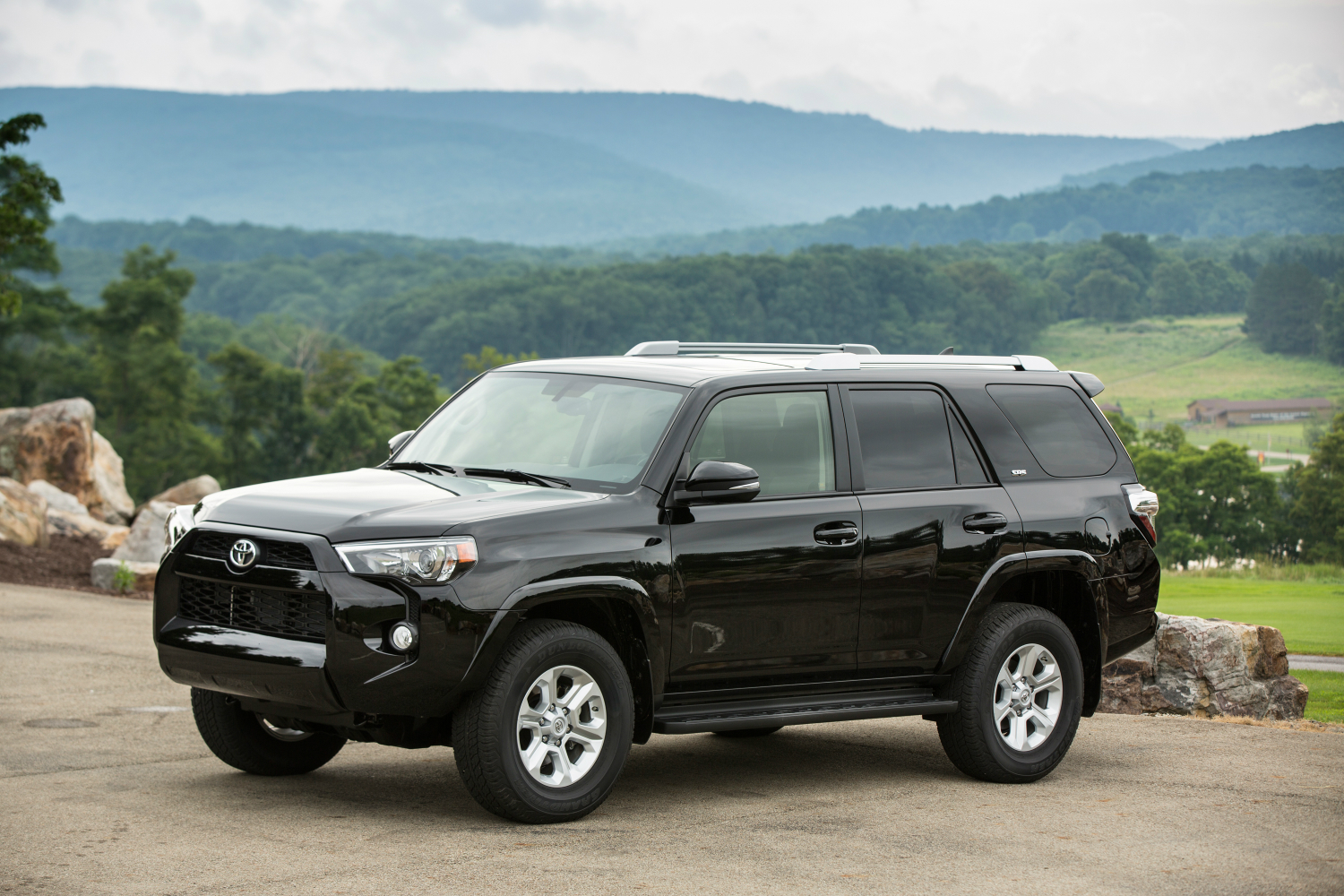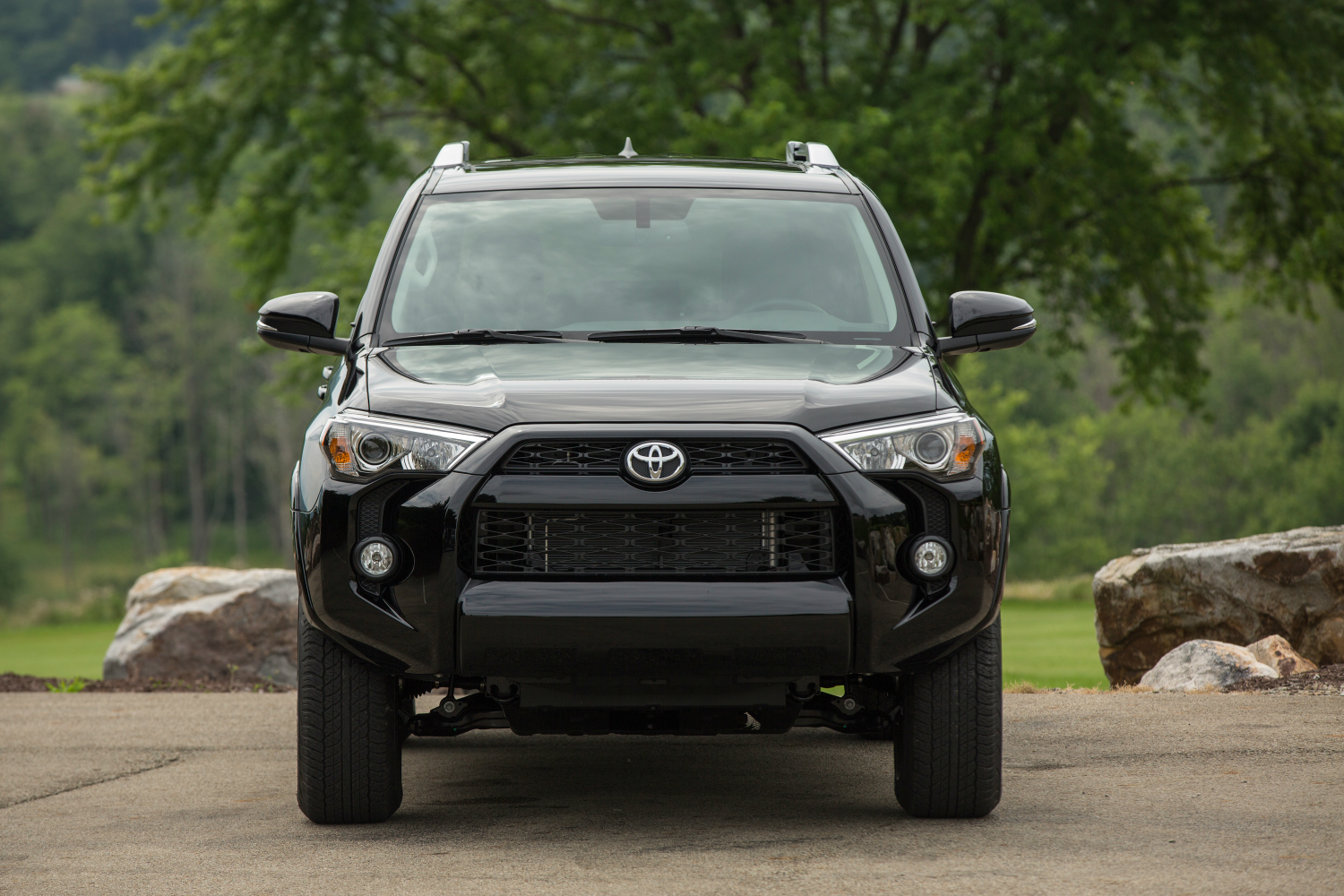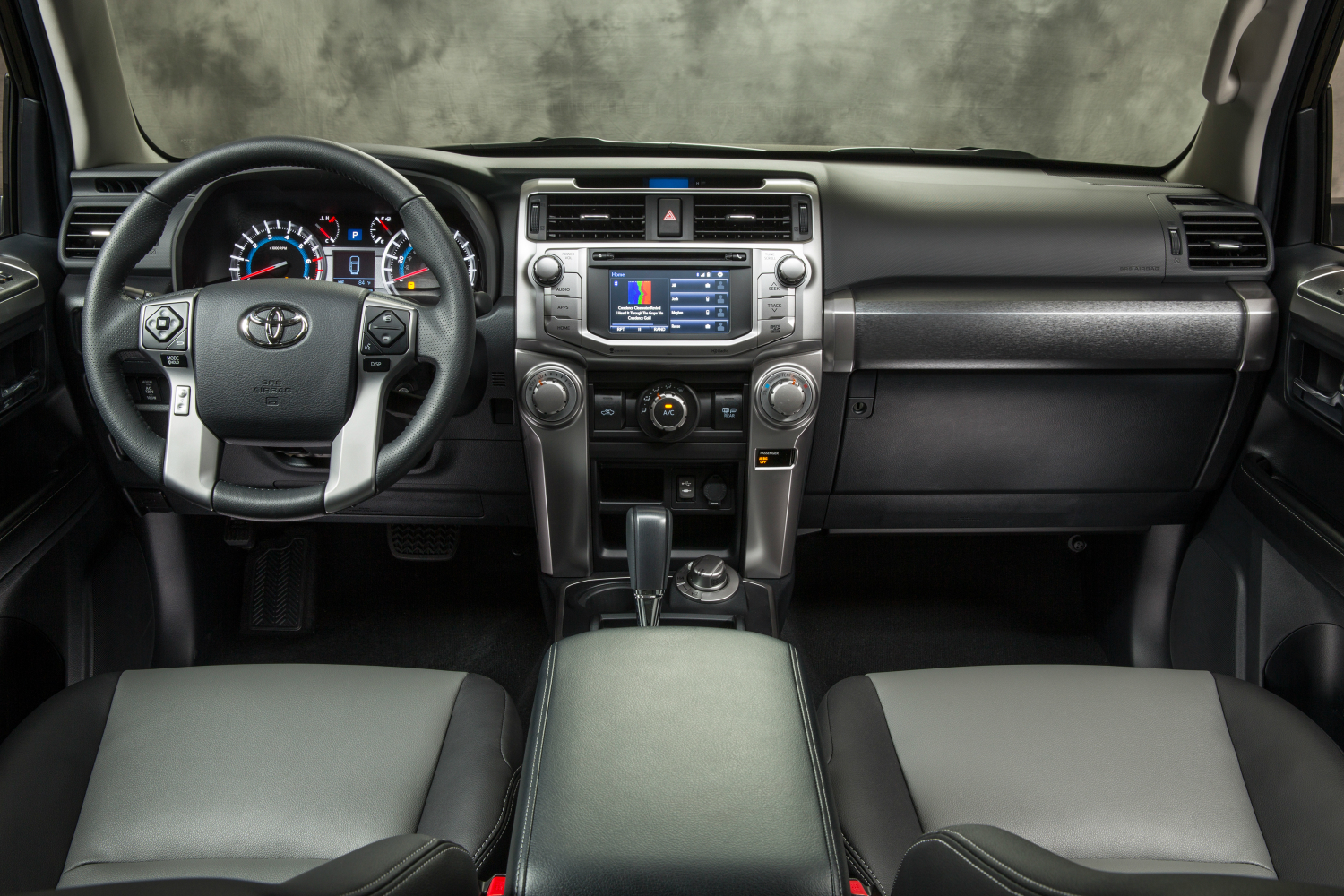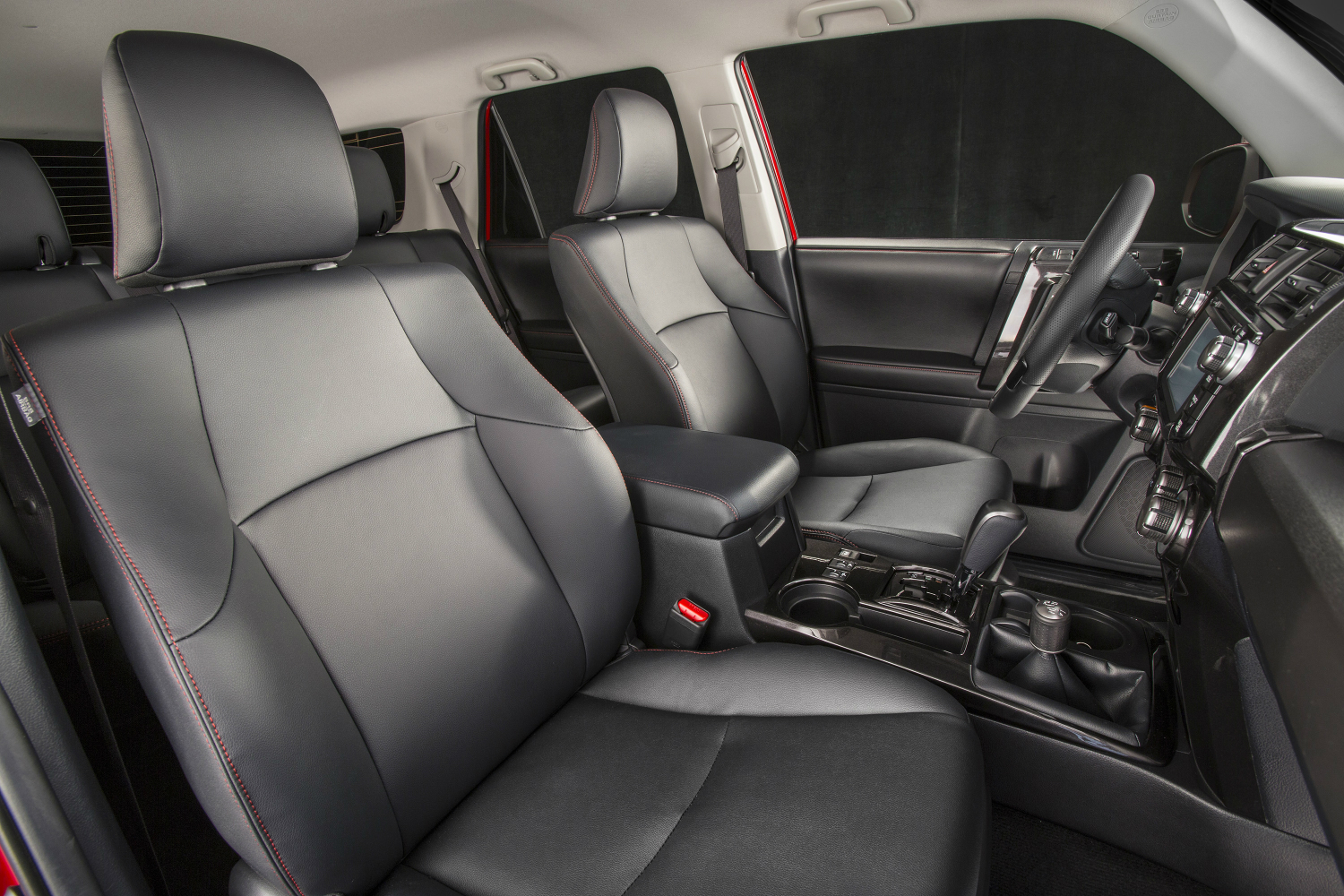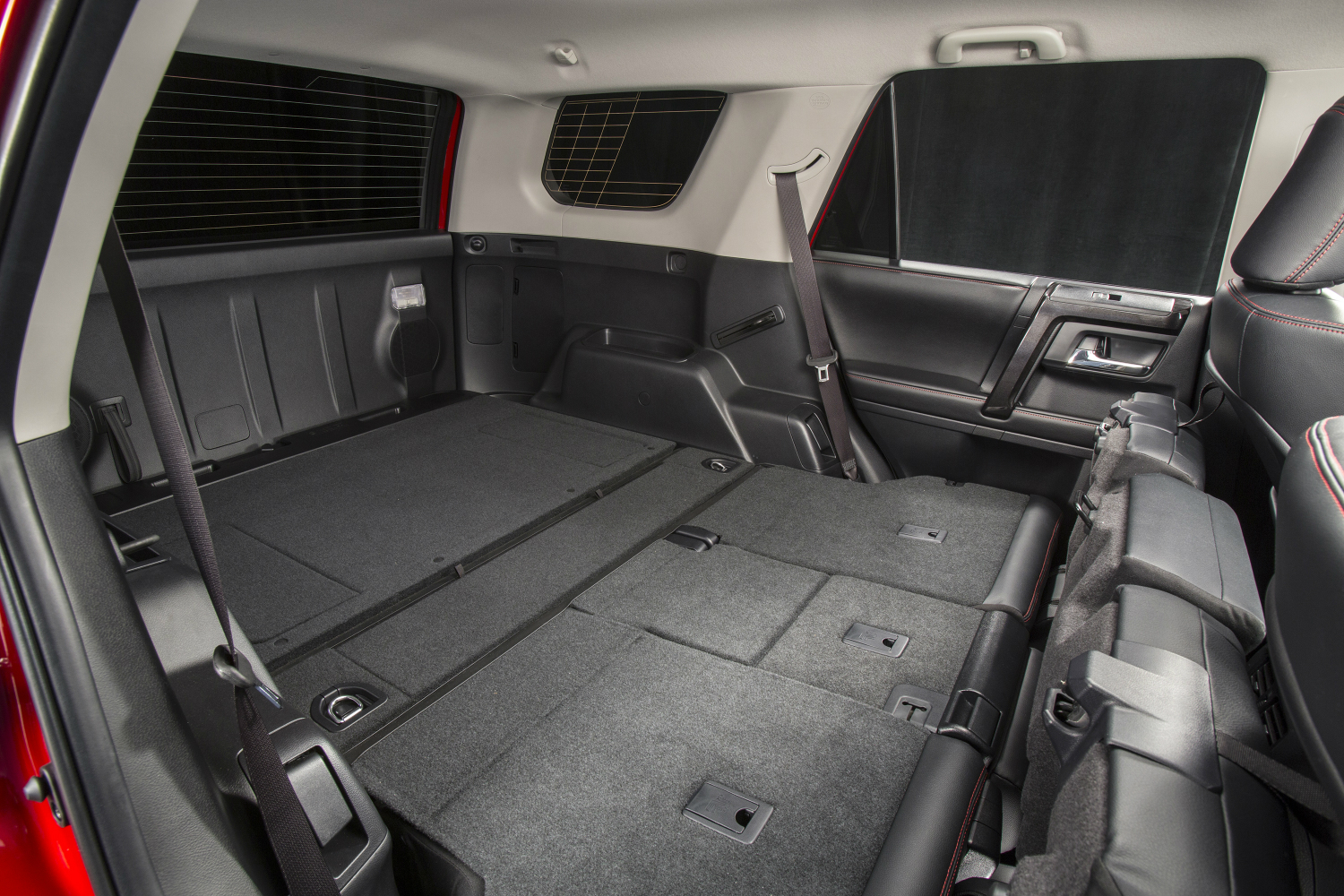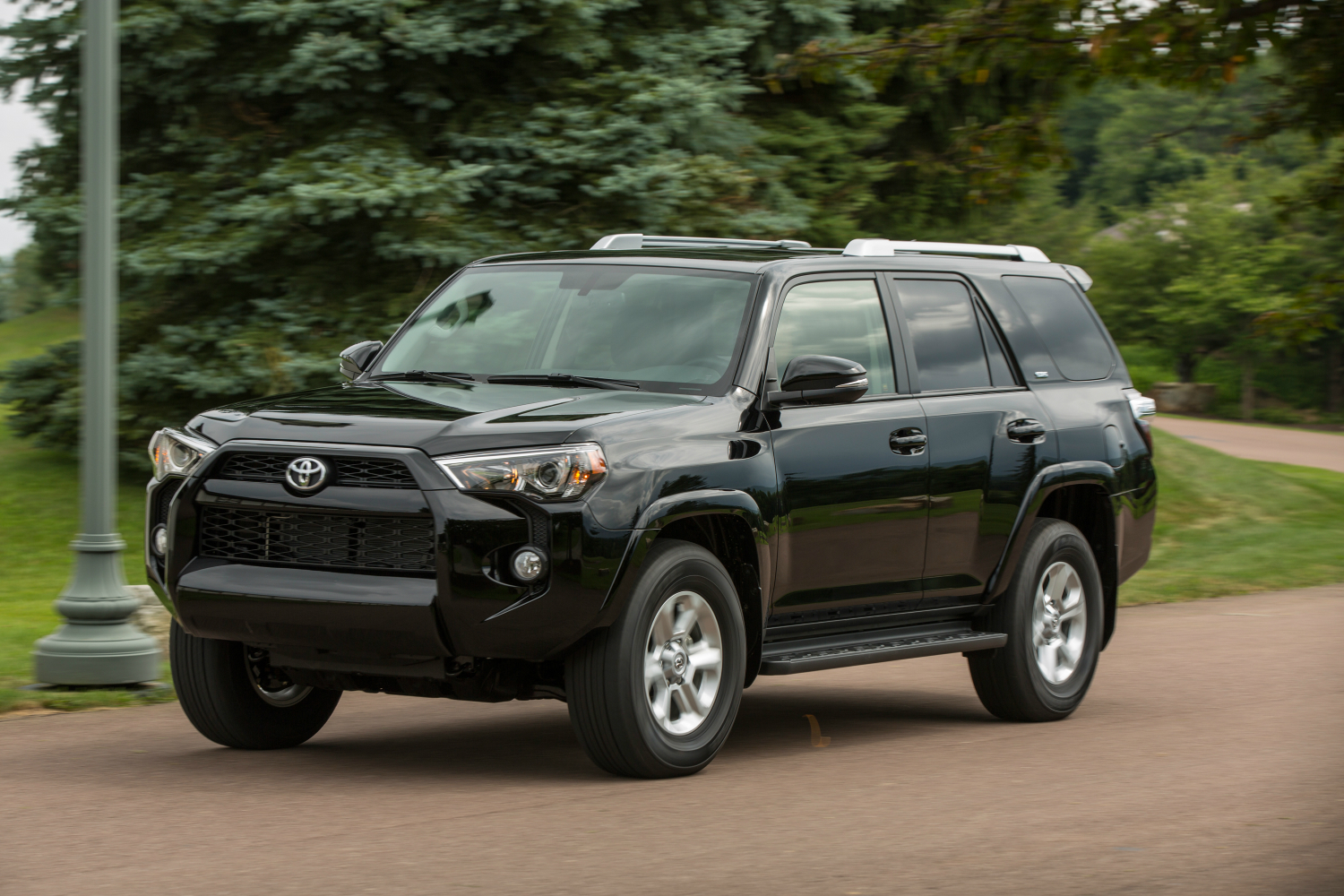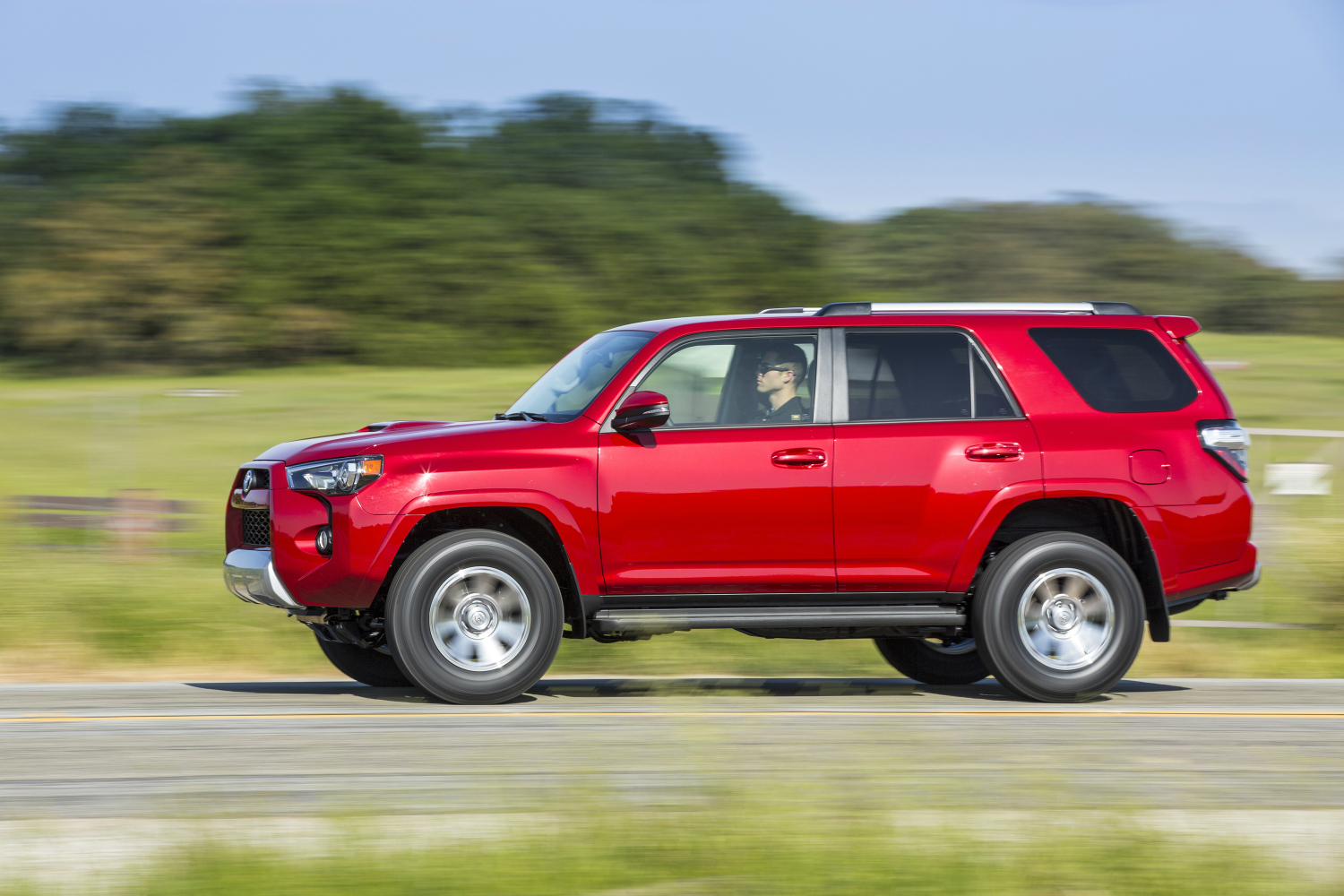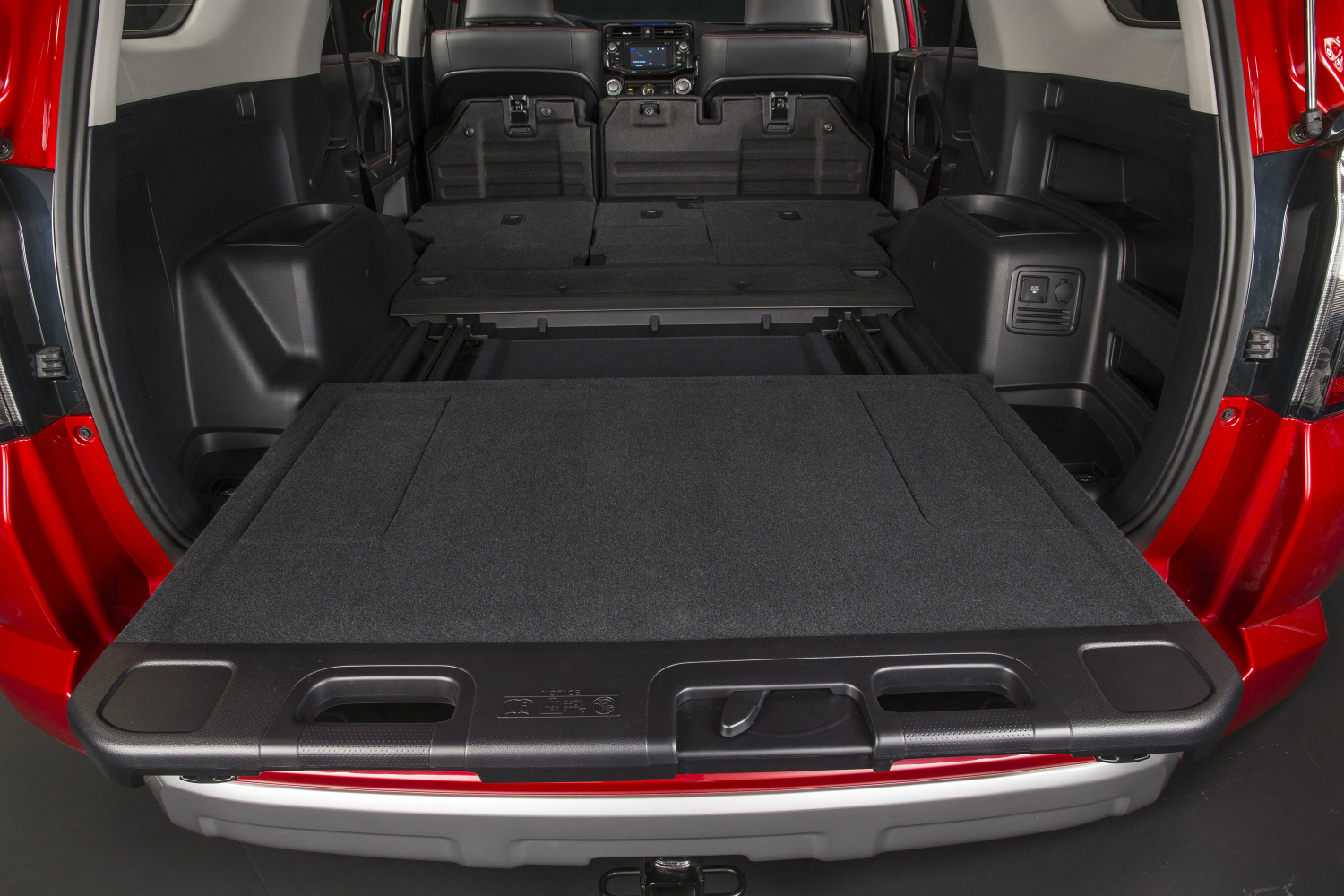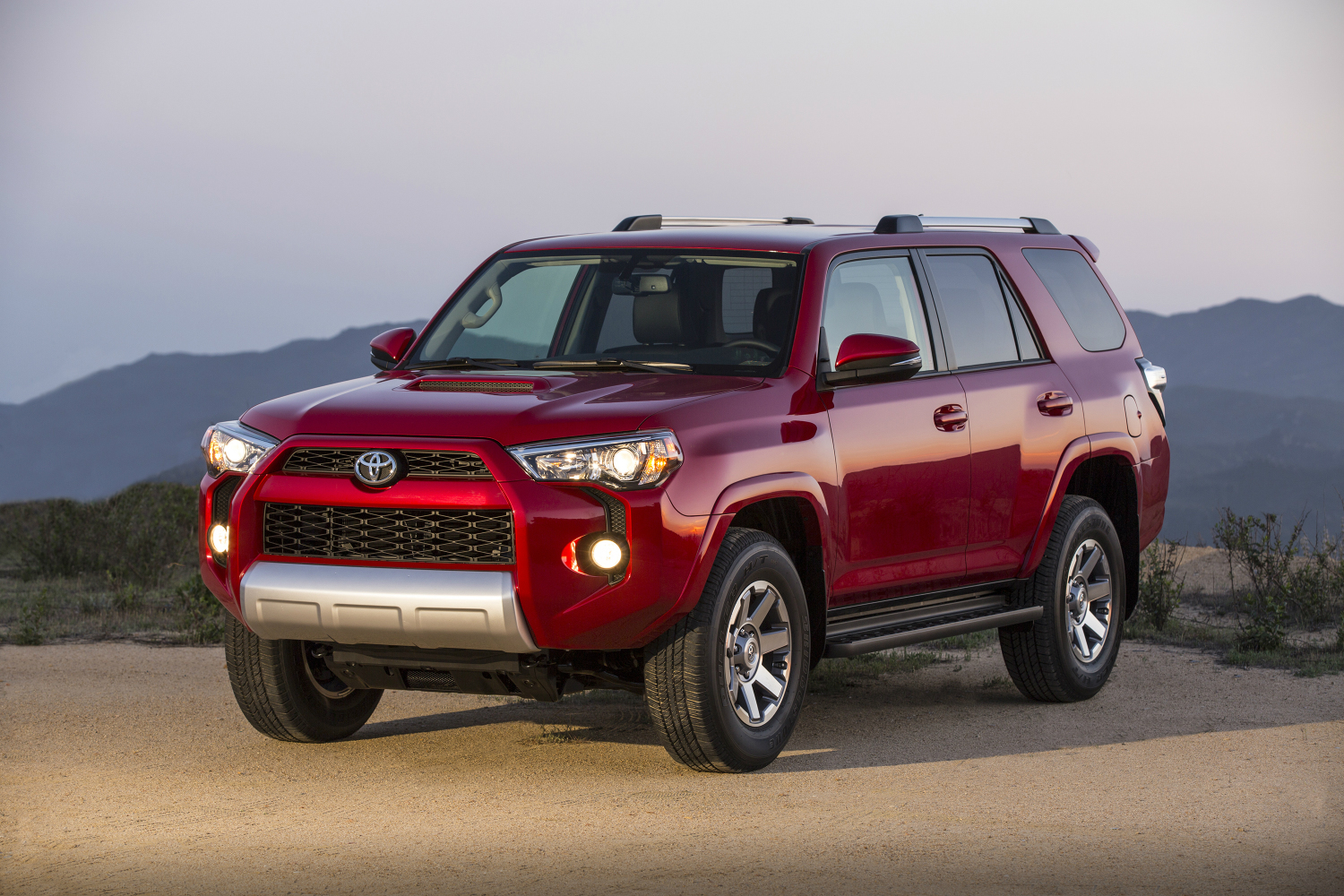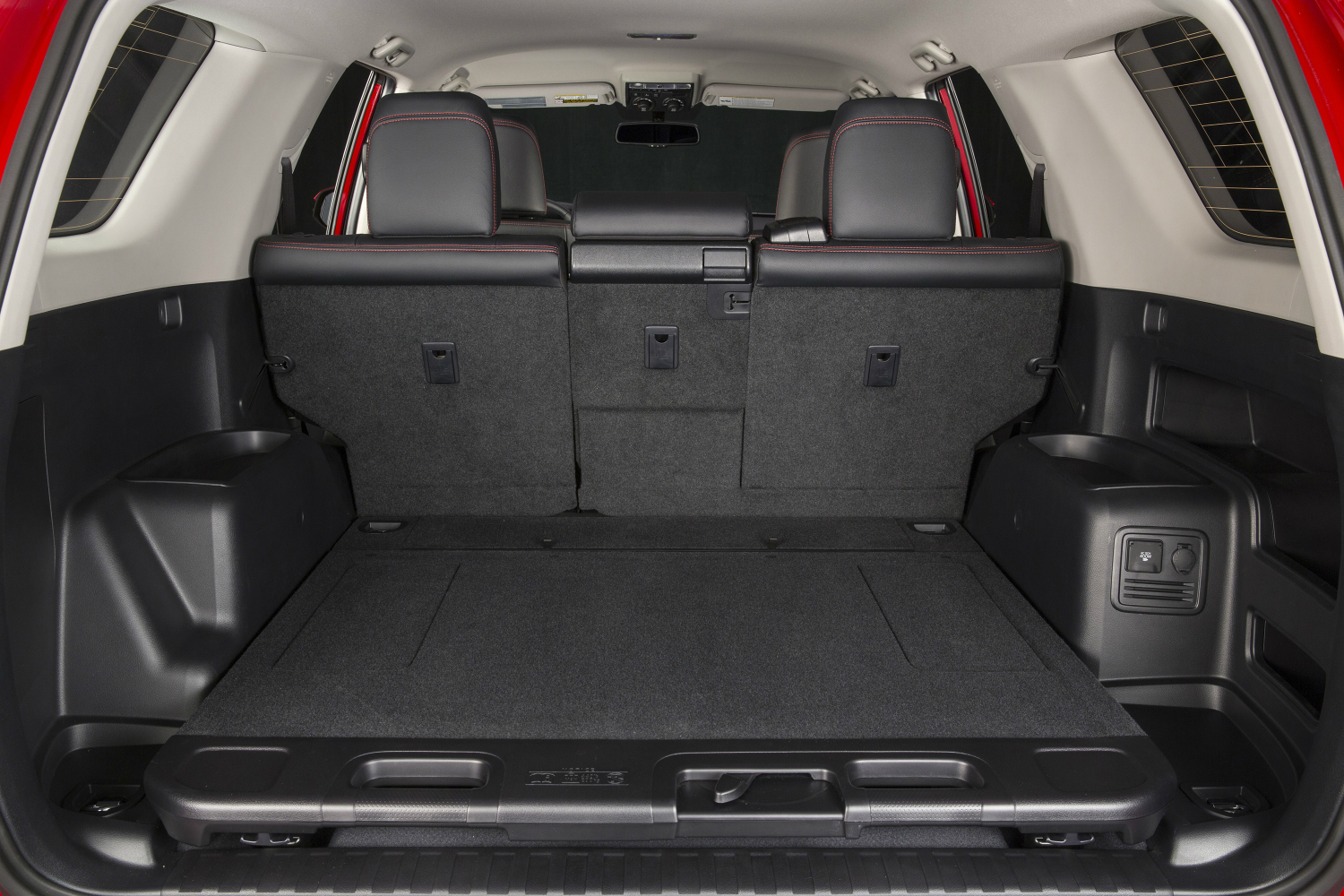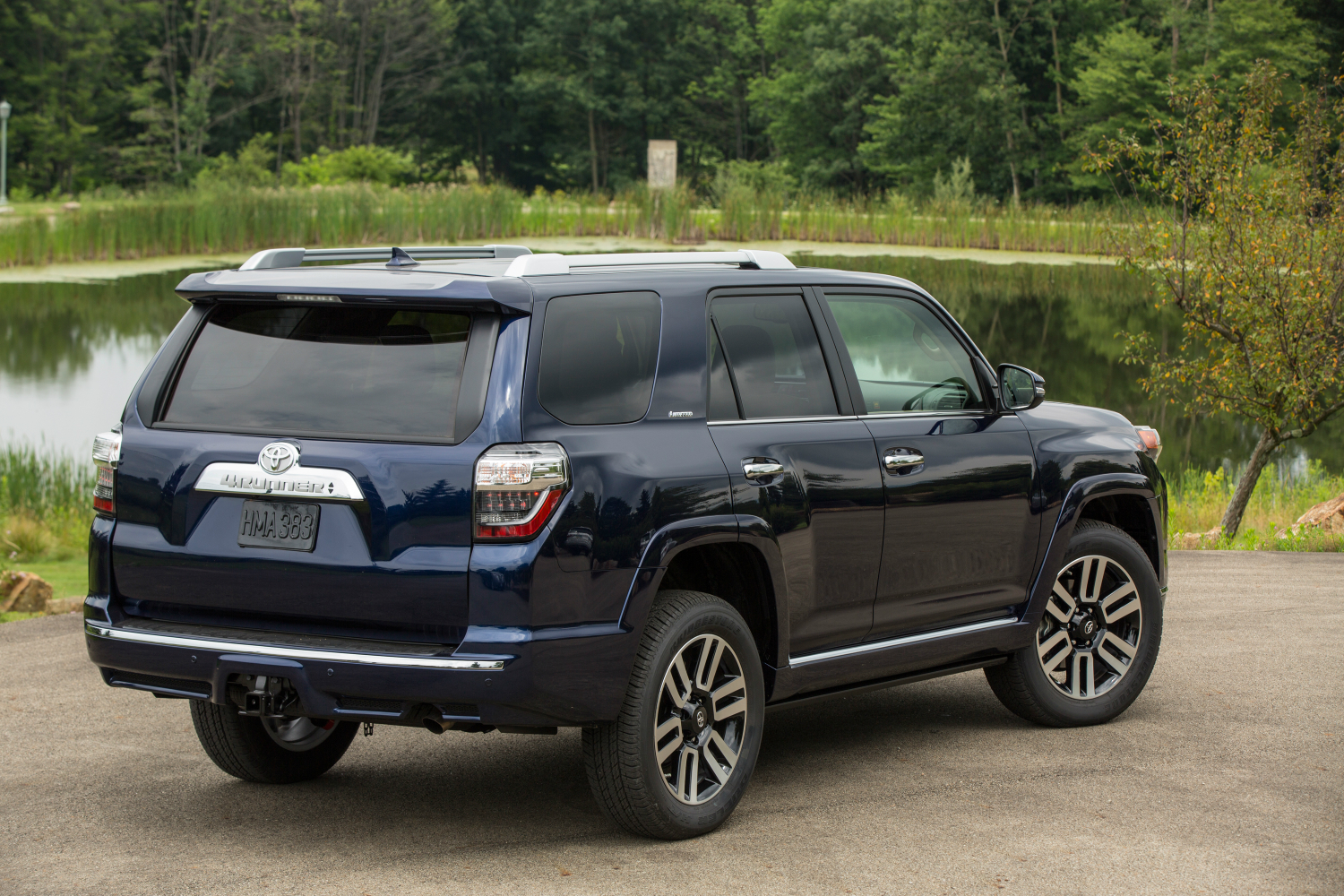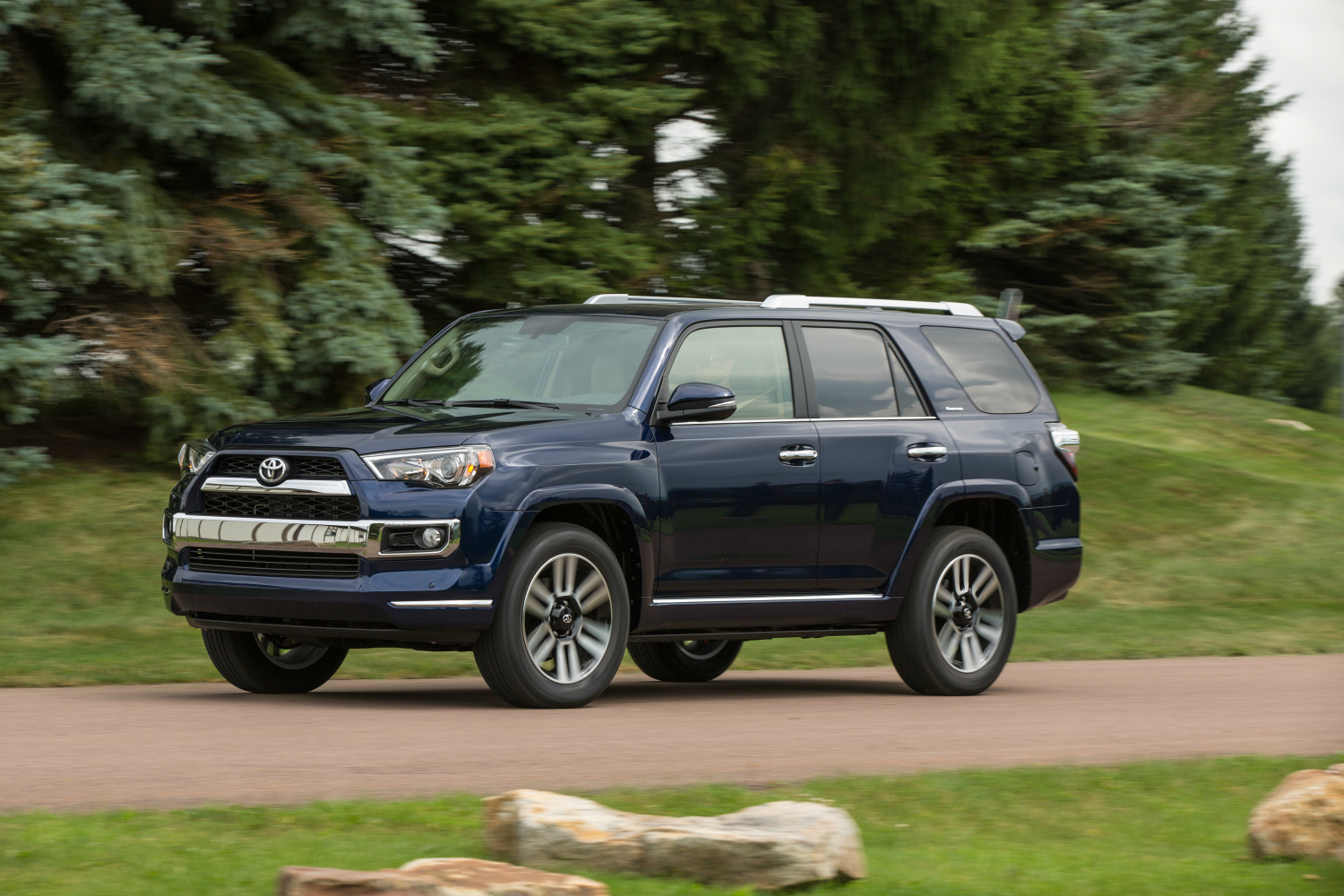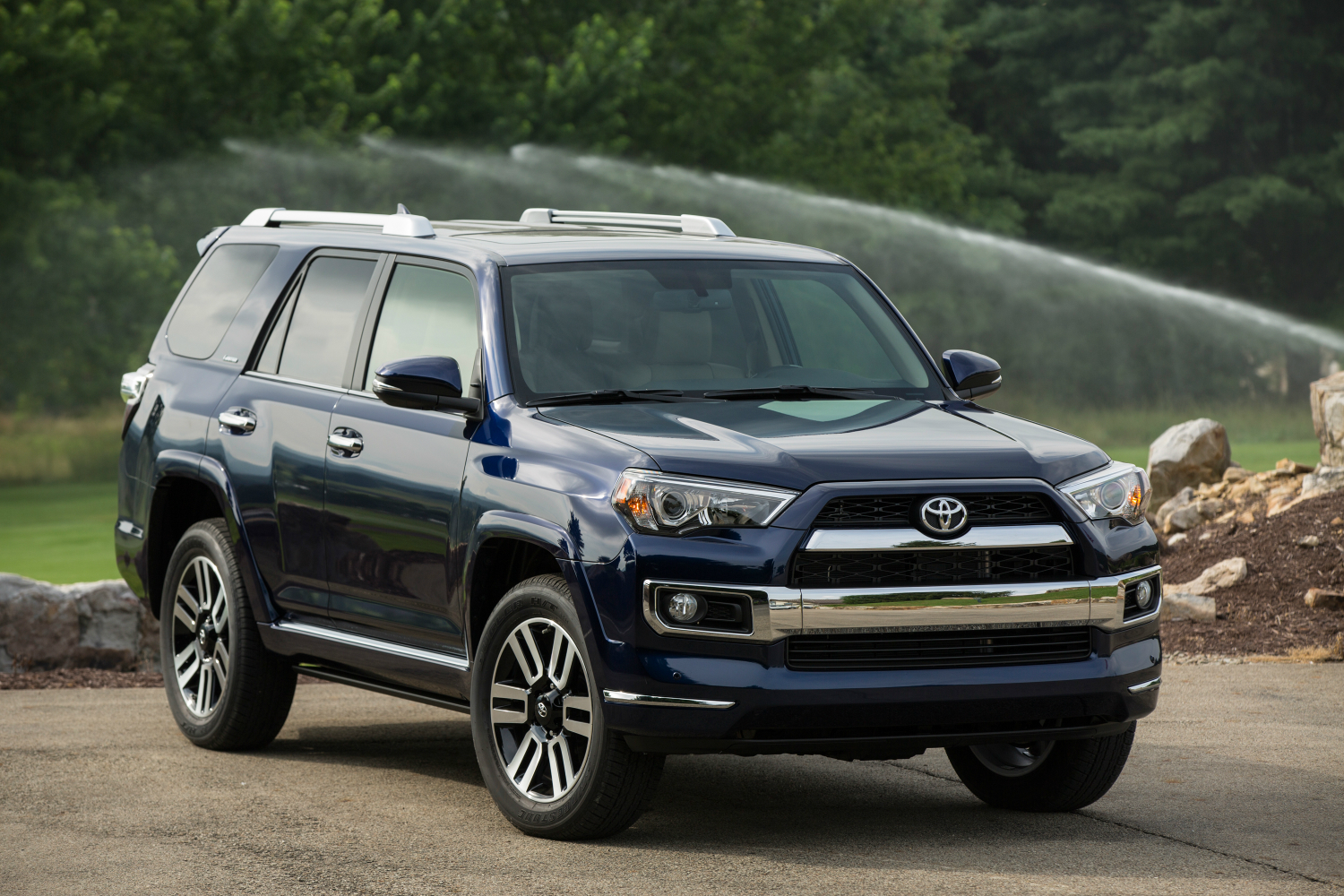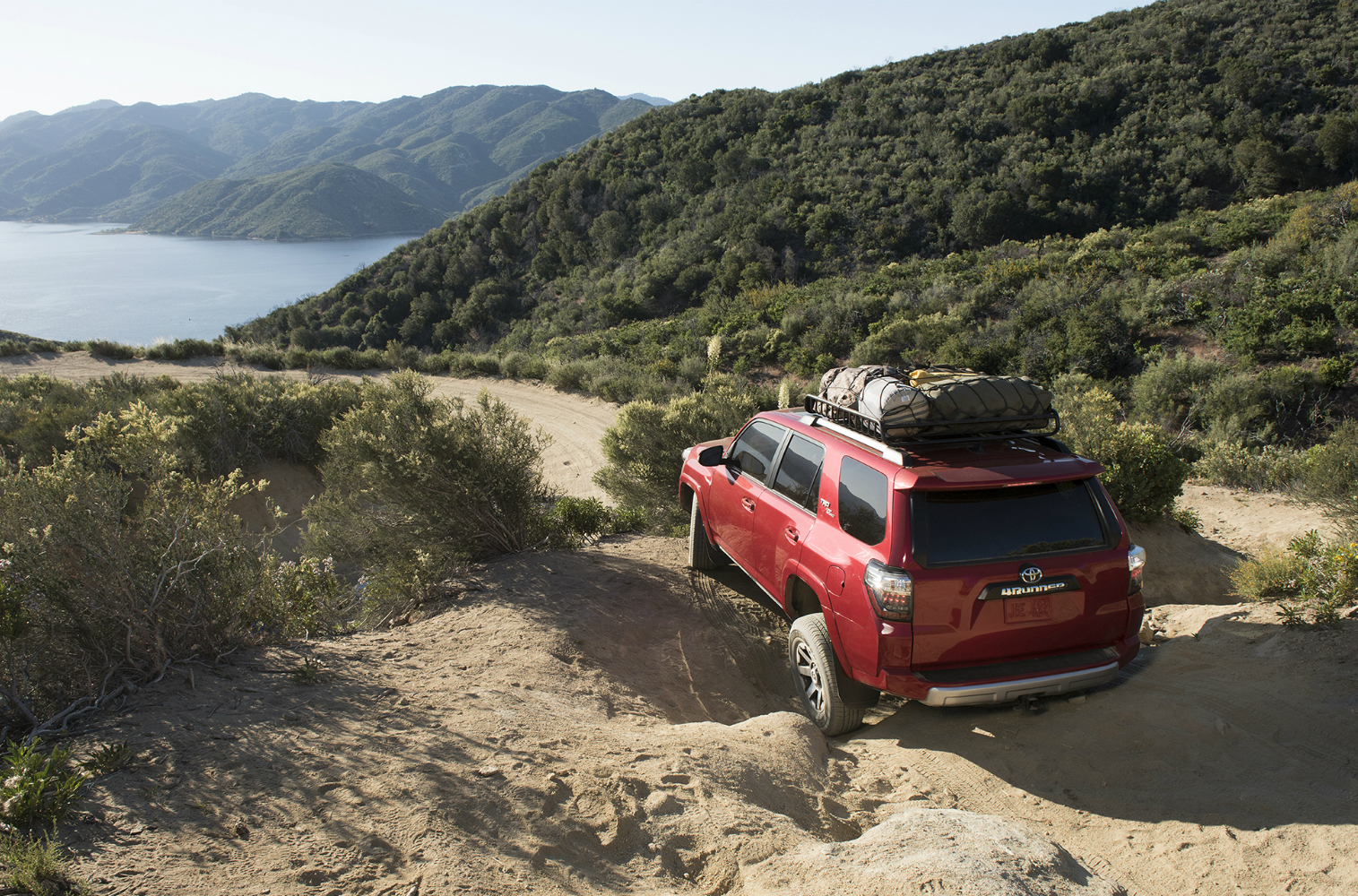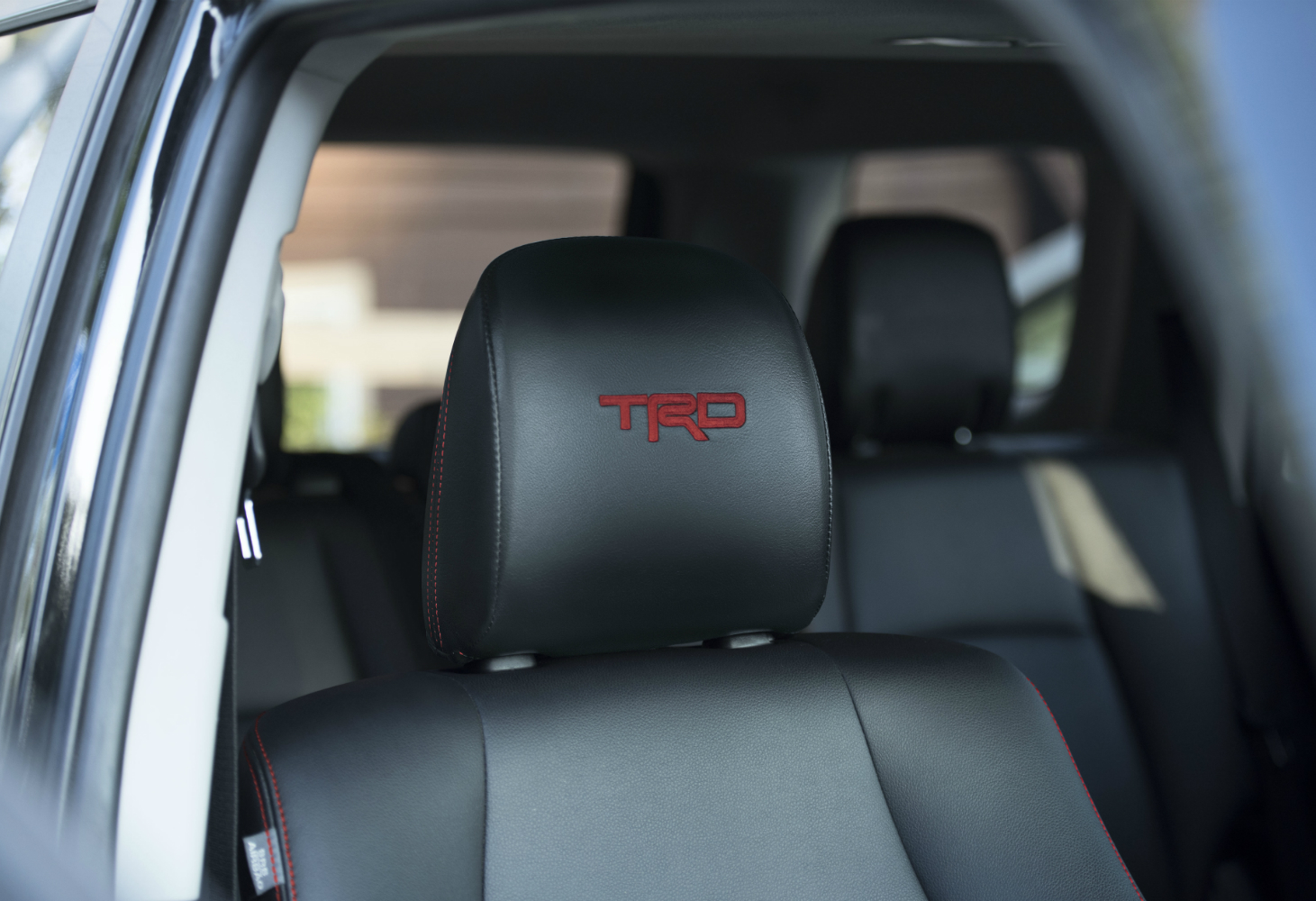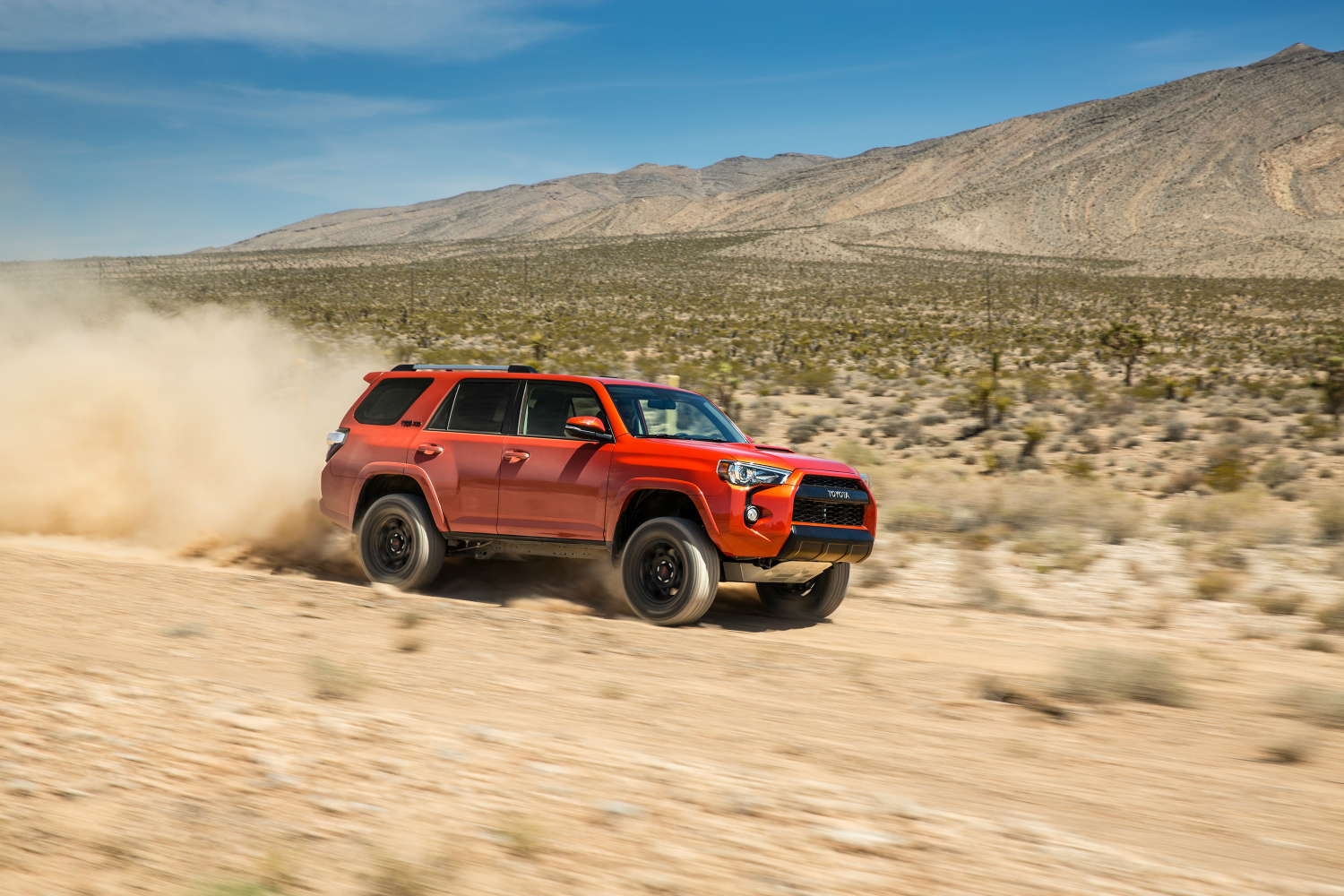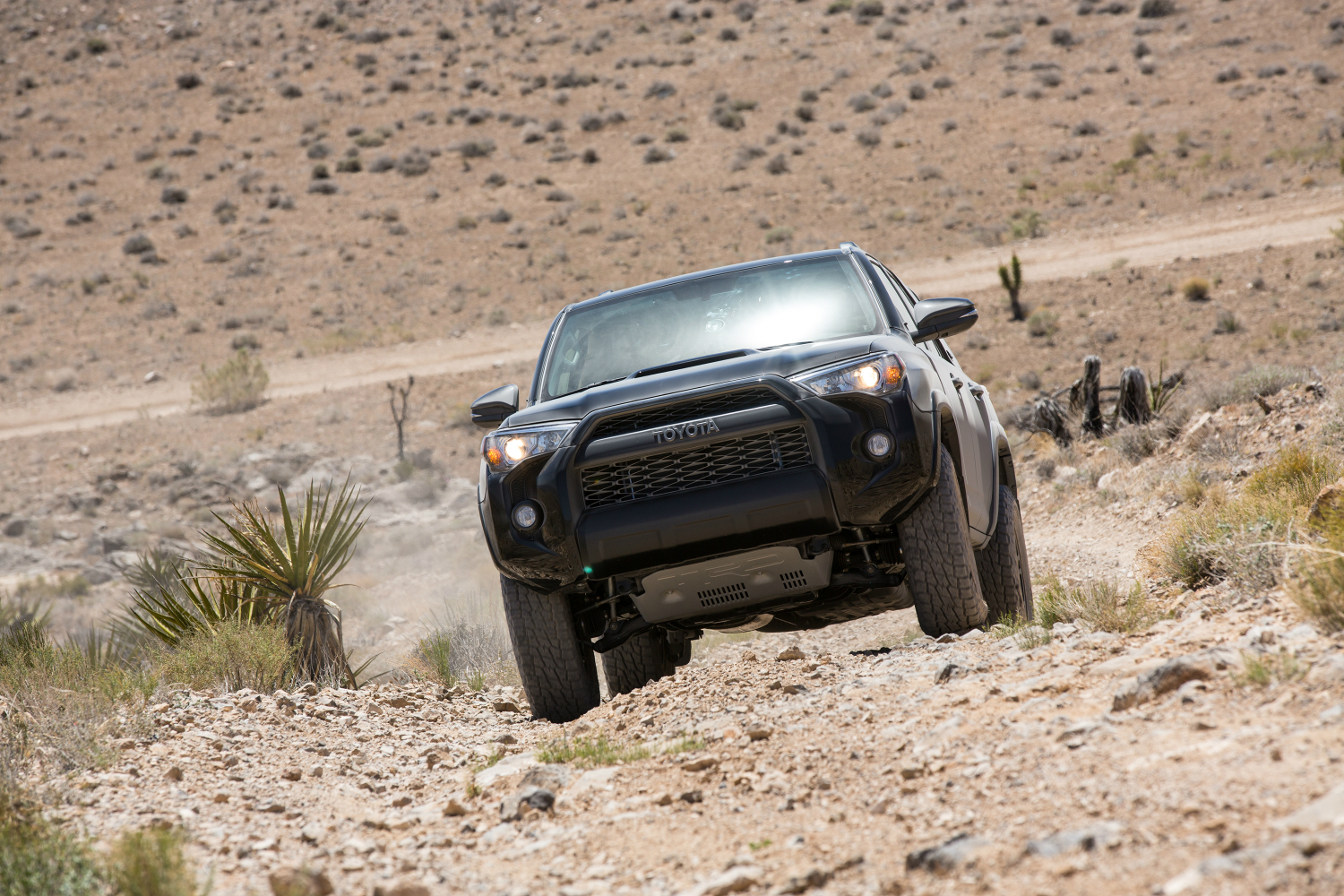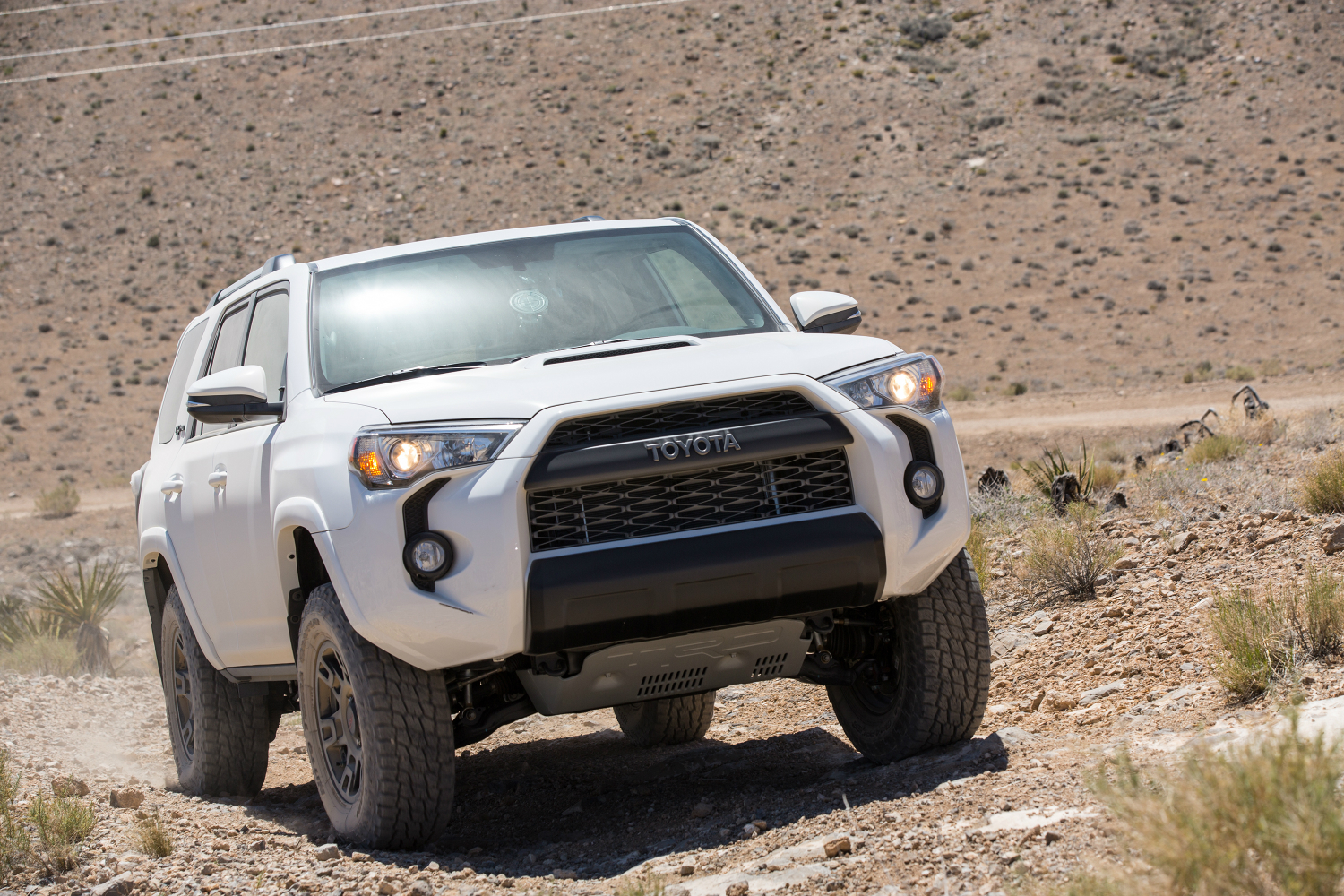The 2018 Toyota 4Runner, now in its 34th year and in the 10th year of the fifth generation, is something of an enigma. The smallest, least expensive, and by far the best-selling body-on-frame SUV in Toyota’s six-vehicle crossover and SUV lineup, the 4Runner is the only one that hasn’t been decked out with Toyota’s passive safety and driver assistive tech suite.
Toyota’s subcompact C-HR, compact Rav4, and mid-size Highlander are all unibody crossovers. The midsize 4Runner, full-size Sequoia, and luxe Land Cruiser are true SUVs. All but the 4Runner have Toyota Safety Sense P (TSS-P) as standard equipment.
The current 4Runner may be getting long in the tooth, but that hasn’t hurt sales. In the 2017 calendar year, Toyota sold 128,296 4Runners, an increase of 14.6 percent from 2016’s 111,952 units. Compare those numbers to the larger Sequoia, which sold 12,156 vehicles in 2017 and the venerable Land Cruiser with a total 3,100 units sold. Together, the Sequoia and Land Cruiser moved a bit fewer than 12 percent of the 4Runners sold in 2017. And yet the Sequoia and Land Cruiser, which stay pretty much the same year after year, now include TSS-P.
What is TSS-P and why doesn’t the 4Runner have it?
TSS-P includes Pre-collision System with Active Braking, Pedestrian Detection, Automatic Emergency Braking, Lane Departure Alert with Steering Assist, Automatic High Beams, and Full-Speed Range Dynamic Radar Cruise Control. That’s quite a list, and some of the group also add Blind Spot Monitoring with Rear Cross Traffic Alert.
The omission of TSS-P on the 4Runner, even as an option, begs the question, “Why not?” The answer that seems logical to Digital Trends is Toyota is working on a new generation 4Runner that will include all of the above safety features and more.
Another thought was maybe there was something about the 4Runner’s platform that precluded adding the safety goodies, but the Tacoma pickup uses the same platform. The Tacoma now has TSS-P as a standard feature for all trims.
When you consider the 4Runner’s reputation for reliability and longevity, which puts it, along with the Land Cruiser, on virtually every cars-you-can-expect-to-keep-for-300,000-miles list, and its continued strong sales, it doesn’t make sense to suggest the model will go away.
Perhaps Toyota is going to borrow from Ford’s F-150 playbook and revamp the 4Runner with aluminum body parts on a steel frame to cut weight and then use a turbocharged smaller engine for improved fuel economy and a wider powerband. We don’t know Toyota’s plans for the 4Runner, but we’re looking forward to the next generation. If Toyota were going to keep the 4Runner the same, as it does the Sequoia and Land Cruiser, it could have already added TSS-P.
What’s new for 2018?
The 2018 4Runner lineup has only two changes of note, both upgrade packages available for various trims. Trims for the 2018 4Runner include the SR5, SR5 Premium, TRD Off-Road, TRD Off-Road Premium, and TRD Pro.
The Wilderness Package, which includes roof rack crossbars, all-weather floor liners, and a cargo tray, is available for the SR5, SR5 Premium, TRD Off-Road, and TRD Off-Road Premium trims. The TRD Enhancement Package, available for the three TRD trims, includes TRD 17-inch matte gray alloy wheels and a TRD-stamped aluminum front skid plate.
2018 Toyota 4Runner powertrain and handling technology
All 2018 4Runners use the same engine, a 270 horsepower 4.0L V6 that produces 278 pound-feet of torque at 4,400 rpm. The only transmission is a 5-speed ECT automatic. The SR5 and SR5 Premium are available with 2WD or part-time 4WD with a 2-speed transfer case. The three TRD trims come with part-time 4WD and a 2-speed transfer case. The luxury trim 4Runner Limited comes with 2WD or full-time 4WD with multiple modes, a 2-speed transfer case, and a locking center differential.
Toyota Star Safety System (TSSS), not to be confused with TSS-P, is standard for all 4Runners. TSSS includes vehicle stability control, traction control, and an anti-lock brake system with electronic brake-force distribution, brake assist, and smart stop technology. Smart stop technology is a brake override system that stops the vehicle from accelerating if the driver inadvertently steps on the brake pedal and the accelerator at the same time.
Hill start assist control is standard with all 4Runners and models with 4WD also have standard downhill assist control.
How to choose a 2018 Toyota 4Runner
While there are six 4Runner trims, your first choice is to decide if you want a basic all-purpose SUV (the SR5 and SR5 Premium), a fancier luxury version (4Runner Limited), or one of three off-road-ish SUVs (TRD Off-Road, TRD Off-Road Premium, or TRD Pro). Only the first three give you a choice of 2wD or 4WD as the TRD trims are 4WD only.
The starting prices range from $34,410 for a 4Runner 2WD SR5 to $44,460 for a 4WD 4Runner Limited for the non-TRD trims. The TRD Off-Road starts at $37,535, and the top-of-the-TRD-range TRD Pro has a $42,675 base price. Figure roughly $2,000 extra for 4WD — $1,875 upgrade for the SR5 and SR5 Premium and $2,035 for the Limited.
We break out the trim differentiation in the text and tables below.
Basic and luxury trims
The base level 2018 4Runner SR5 is available with the rear-wheel drive version starting at $34,410 and with part-time 4WD with Active Traction Control with a $36,285 starting price. Automatic limited-slip control is standard on the 2WD versions and downhill assist control is included only with 4WD models. All SR5s have fog lights, projector-beam headlights, and skid plates for the engine, front suspension, and fuel tank. The 4WD versions have transfer case skid plates. SR5s have 17-inch alloy wheels rearview cameras with projected backup path displays, and leather trimmed-steering wheels with audio an Bluetooth hands-free phone and voice controls.
SR5s have cloth seats with 8-way power adjustments for the driver’s seat with lumbar support and 4-way manual adjustment for the front passenger seat. The Entune Audio Plus infotainment system has a 6.1-inch, high-resolution touchscreen display with a connected navigation app — meaning you use your smartphone mapping software. Major options include third-row seating a sliding cargo deck, and an upgraded infotainment system with integrated navigation.
For an extra $1,830 over the SR5 list price, you can move up to the 2018 4Runner SR5 Premium with some of the most popular upgrades. Starting at $36,240 with 2WD and $38,115 or the 4WD version, the SR5 Premium adds heated power outside mirrors with turn signal indicators, SofTex-trimmed heated front seats, and a 4-way power-adjustable front passenger seat.
The SR5 Premium trim also includes Entune Premium Audio with integrated navigation and an auto-dimming rearview mirror with a HomeLink universal transceiver. The options list includes a power moonroof and running boards.
The luxury 4Runner is the Limited, starting at $42,725 with rear-wheel drive or $44,760 with 4WD, active traction control, and a Torsen limited-slip differential with locking. The $6,485 price jump from the SR5 Premium trim adds performance, comfort, convenience, and luxury starting with an X-Reas Sport Enhancement suspension, 20-inch wheels, a power moonroof, and front and rear parking assist sonar.
Inside the 4Runner Limited trim passengers enjoy an illuminated entry, a smart key system with push-button start, perforated leather-trimmed heated and ventilated front seats, dual-zone automatic climate control, memory function for the power driver’s seat, Entune’s Premium JBL Audio with integrated navigation and app suite. Automatic running boards are optional.
| Trim | 2018 4Runner SR5 | 2018 4Runner SR5 Premium | 2018 4Runner Limited |
| Base price 4×2 | $34,410 | $36,240 | $42,725 |
| Base price 4×4 | $36,285 | $38,115 | $44,760 |
| Drive wheels | Rear or 4WD | Rear or 4WD | Rear or 4WD |
| Base engine | 4.0L V6 | 4.0L V6 | 4.0L V6 |
| Base horsepower | 270 hp @ 5,600 rpm | 270 hp @ 5,600 rpm | 270 hp @ 5,600 rpm |
| Base torque | 278 lb-ft @ 4,400 rpm | 278 lb-ft @ 4,400 rpm | 278 lb-ft @ 4,400 rpm |
| Transmission | 5-speed automatic | 5-speed automatic | 5-speed automatic |
| Fuel | Regular gas | Regular gas | Regular gas |
| Fuel capacity | 23 gallons | 23 gallons | 23 gallons |
| Fuel economy 4×2 | 17 city mpg/21 mpg highway/18 mpg combined | 17 city mpg/21 mpg highway/18 mpg combined | 17 city mpg/21 mpg highway/18 mpg combined |
| Fuel economy 4×4 | 17 city mpg/20 mpg highway/18 mpg combined | 17 city mpg/20 mpg highway/18 mpg combined | 17 city mpg/20 mpg highway/18 mpg combined |
| Base wheels | 17-inch | 17-inch | 20-inch |
| Body style | 4-door SUV | 4-door SUV | 4-door SUV |
| Passengers | 5/7 | 5/7 | 5/7 |
| Third-row seating | Optional 2 passenger | Optional 2 passenger | Optional 2 passenger |
| Storage behind third-row seats | 9.0 cubic feet | 9.0 cubic feet | 9.0 cubic feet |
| Storage behind second-row seats | 46.3 cubic feet | 46.3 cubic feet | 46.3 cubic feet |
| Storage behind first-row seats | 88.8 cubic feet | 88.8 cubic feet | 88.8 cubic feet |
| Max towing capacity | 5,000 pounds | 5,000 pounds | 5,000 pounds |
| Seat upholstery | Cloth | SofTex | Perforated leather |
TRD trims
The 2018 4Runner TRD Off-Road trim starts at $37,535. The TRD Off-Road has a part-time 4WD system with a locking rear differential, active traction control, hill start assist control, and Multi-terrain Select and Crawl Control with an overhead console with switches for terrain selection and crawl modes.
In addition to features standard on the SR5, the TRD Off-Road trim has 17-inch, 7-spoke alloy wheels with P265/70R17 tires and black-painted accents, unique accent colors and badges, a TRD shift knob, and TRD Off-Road floor mats. Toyota’s Kinetic Dynamic Suspension System, optional on the TRD Off-Road, automatically adjusts front and rear stabilizer bars using a mechanical, hydraulic system that reacts when the system senses a wheel dropping.
For an additional $1,960, you can move up from the TRD Off-Road trim to the TRD Off-Road Premium level, starting price $39,495. This package doesn’t add to off-road performance but makes life a bit more comfortable. The Off-Road Premium trim adds heated power outside mirrors with turn signal indicators, SofTex-trimmed heated front seats with “TRD” in red letters on the headrests, an 8-way power-adjustable driver’s seat with power lumbar support, a 4-way power-adjustable front passenger seat, Entune’s Premium Audio with integrated navigation, an auto-dimming rearview mirror with a HomeLink universal transceiver.
The top TRD trim, the TRD Pro, a $3,180 jump from the Off-Road Premium with its $42,675 starting price notches up the off-road performance significantly. The TRD Pro adds Bilstein high-performance shocks with rear remote reservoirs, TRD-tuned front springs, TRD-stamped aluminum front skid plate, and TRD 17-inch matte-black alloy wheels with P265/70R17 A/T tires. The TRD Pro package also includes unique external badges and front grille, a TRD shift knob and TRD Pro floor mats, plus auto on/off headlghts and a HomeLink transceiver.
| Trim | 2018 4Runner TRD Off-Road | 2018 4Runner TRD Off-Road Premium | 2018 4Runner TRD Pro |
| Base price 4×4 | $37,535 | $39,495 | $42,675 |
| Drive wheels | Part-time 4WD | Part-time 4WD | Part-time 4WD |
| Base engine | 4.0L V6 | 4.0L V6 | 4.0L V6 |
| Base horsepower | 270 hp @5,600 rpm | 270 hp @5,600 rpm | 270 hp @5,600 rpm |
| Base torque | 278 lb-ft @4,400 rpm | 278 lb-ft @4,400 rpm | 278 lb-ft @4,400 rpm |
| Transmission | 5-speed automatic | 5-speed automatic | 5-speed automatic |
| Fuel | Regular gas | Regular gas | Regular gas |
| Fuel capacity (gallons) | 23 gallons | 23 gallons | 23 gallons |
| Fuel economy 4×4 | 17 city mpg/20 mpg highway/18 mpg combined | 17 city mpg/20 mpg highway/18 mpg combined | 17 city mpg/20 mpg highway/18 mpg combined |
| Base wheels | 17-inch | 17-inch | 17-inch |
| Body style | 4-door SUV | 4-door SUV | 4-door SUV |
| Passengers | 5 | 5 | 5 |
| Third-row seating | Not available | Not available | Not available |
| Storage behind second-row seats | 46.3 cubic feet | 46.3 cubic feet | 46.3 cubic feet |
| Storage behind first-row seats | 88.8 cubic feet | 88.8 cubic feet | 88.8 cubic feet |
| Max towing capacity | 5,000 pounds | 5,000 pounds | 5,000 pounds |
| Seat upholstery | Cloth | SofTex | SofTex |
Editors' Recommendations
- Everything we know about the Polestar 4: range, price, release date
- Kia EV4: design, rumored pricing, release date, and more
- Volvo EX30 price, range, release date, specs, and more
- 2021 Toyota RAV4 vs. 2021 Subaru Forester
- 2021 Toyota RAV4 Prime adds fuel efficiency and power in equal measure

